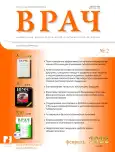Phenotypes of occupational bronchial asthma (functional, immunological features, prognosis)
- Authors: Babanov S.A1, Baikova A.G1, Strizhakov L.A2, Agarkova A.S1
-
Affiliations:
- Samara State Medical University of the Ministry of Health of Russia
- I.M. Sechenov First Moscow State Medical University (Sechenov University) of the Ministry of Health of Russia
- Issue: Vol 33, No 2 (2022)
- Pages: 50-55
- Section: Articles
- URL: https://journals.eco-vector.com/0236-3054/article/view/114575
- DOI: https://doi.org/10.29296/25877305-2022-02-08
- ID: 114575
Cite item
Abstract
Occupational asthma is a complex and heterogeneous disease. Development of personalized treatment and prevention tactics becomes feasible due to phenotyping, which means identifying of markers to combine cases of occupational asthma with similar manifestations (clinical, instrumental, laboratory) and prognosis to phenotypes. The study aims to determination and comparative analysis of spirographic and immunological parameters for different phenotypes of occupational asthma. Materials and methods. In this study, we included 170 patients with different phenotypes of occupational asthma and 50 participants in control group. The spirographic examination was performed using computer spirograph with determination of the following parameters: forced vital capacity (FVC), forced expiratory volume during the first second (FEV1), Tiffeneau-Pinelli index (FEV1/ FVC), peak expiratory flow (PEF), maximal expiratory flow at 75%, 50%, 25% of the forced vital capacity (MEF75%VC, MEF50%VC, MEF25%VC). Quantification of the immunoglobulins IgA, IgM, and IgG in human serum was conducted by Mancini method. Determination of cytokines IL-1β, IL-10, IFNγ, IgE total and fibronectin levels was hold using a solid-phase enzyme immunoassay. Results. According to spirometry and laboratory results obtained, there is a strong evidence, that the phenotype “occupational asthma - occupational chronic obstructive pulmonary disease" has the lowest values in pulmonary function tests and the most significant changes in immunoglobulins, cytokines and fibronectin levels among other studied phenotypes of occupational asthma. Conclusions. Dynamic determination of spirometry parameters, levels of immunoglobulins, cytokines IL-1β, IL-10, IFNγ and fibronectin in workers who are most at risk of developing occupational asthma may be recommended to be conducted once every six months with further phenotyping of identified cases. This can optimize the diagnosis, the choice of treatment and prevention tactics as well as predict the course of this pathology.
Full Text
About the authors
S. A Babanov
Samara State Medical University of the Ministry of Health of Russia
Email: s.a.babanov@mail.ru
Professor
A. G Baikova
Samara State Medical University of the Ministry of Health of Russia
Email: s.a.babanov@mail.ru
L. A Strizhakov
I.M. Sechenov First Moscow State Medical University (Sechenov University) of the Ministry of Health of Russia
Email: s.a.babanov@mail.ru
Professor
A. S Agarkova
Samara State Medical University of the Ministry of Health of Russia
Author for correspondence.
Email: s.a.babanov@mail.ru
References
- Профессиональная бронхиальная астма. Федеральные клинические рекомендации. Утверждены Ассоциацией врачей и специалистов медицины труда. М., 2017
- GINA Report, Global Strategy for Asthma Management and Prevention. Published November 2018. Available at: http://www.ginasthma.org
- Ненашева Н.М. Фенотипы бронхиальной астмы и выбор терапии. Практическая пульмонология. 2014; 2: 2-11
- Курбачева О.М. Бронхиальная астма. Что можно сделать для достижения контроля заболевания? Российский аллергологический журнал. 2012; 2: 28-34
- Tilles S.A., Jerath-Tatum A. Differential diagnosis of occupational asthma. Immunol Allergy Clin N. Am. 2003; 23 (2): 167-76. doi: 10.1016/s0889-8561(02)00089-9
- Nikolskii A.A., Shilovskiy I.P., Andreev S.M. et al. STAT3 gene suppression as an approach for the treatment of non-allergic bronchial asthma. Allergy. 2019; 74 (s106): 67.
- Sastre J., Vandesplas O., Park H.S. Pathogenesis of occupational asthma. EurRespir J. 2003; 22 (2): 364-7. doi: 10.1183/09031936.03.00045103
- Wan H., Winton H.L., Soeller C. et al. Der p1 facilitates transepithelial allergen delivery by disruption of tight functions. J. Clin Invest. 1999; 104 (1): 123-33. doi: 10.1172/JCI5844
- Agius R.M., Nee J., Mc Govern B. et al. Structure activity hypotheses in occupational asthma caused by low molecular weight substances. Ann Occup Hyg. 1991; 35 (2): 129-31. doi: 10.1093/annhyg/35.2.129
- Niespodziana K., Borochova K., Pazderova P. et al. Toward personalization of asthma treatment according to trigger factors. J. Allergy Clin Immunol. 2020; 145 (6): 1529-34. doi: 10.1016/j.jaci.2020.02.001
- Cormier M., Lemiere C. Occupational asthma. Int J. Tuberc. Lung Dis. 2020; 24 (1): 8-21. doi: 10.5588/ijtld.19.0301
- Vandenplas O., Suojalehto H., Cullinan, P. Diagnosing occupational asthma. Clin Exp Allergy. 2017; 47 (1): 6-18. doi: 10.1111/cea.12858
Supplementary files










